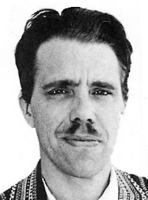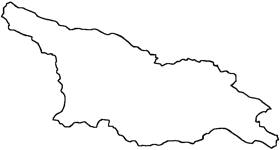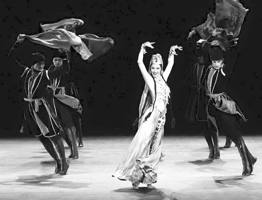
|
The Society of Folk Dance Historians (SFDH)
Folk Music and Dance of Georgia
[
Home |
About |
Encyclopedia | CLICK AN IMAGE TO ENLARGE |

|
FOLK MUSIC OF GEORGIA
 The folk music of Georgia can generally be divided into three eras: (1) the Pre-Christian times; and since Christianity developed in the country (circa 325); (2) the historical; and (3) the contemporary periods of Christianity. It is formulated on modes that do not fit into the common Western tradition of major-minor system and is basically vocal music, quite related to the text. The instrumental music is not important for there are not only noted instrumentalists and orchestras throughout the country, but the National Symphony Orchestra of Tbilisi is one of the finest in the area, and the Georgian State Ballet has achieved the "impossible" in creating a libretto and choreography with a musical score for "Othello" which has been performed far beyond the boundaries of the region. Though folk themes are used, however, it is not true of folk music.
The folk music of Georgia can generally be divided into three eras: (1) the Pre-Christian times; and since Christianity developed in the country (circa 325); (2) the historical; and (3) the contemporary periods of Christianity. It is formulated on modes that do not fit into the common Western tradition of major-minor system and is basically vocal music, quite related to the text. The instrumental music is not important for there are not only noted instrumentalists and orchestras throughout the country, but the National Symphony Orchestra of Tbilisi is one of the finest in the area, and the Georgian State Ballet has achieved the "impossible" in creating a libretto and choreography with a musical score for "Othello" which has been performed far beyond the boundaries of the region. Though folk themes are used, however, it is not true of folk music.
The characteristic feature of Georgian folk music is "part-music," usually for three voices. A manuscript collection of Georgian songs and hymns was collected back in the late 10th century and indicates that polyphony was extant back to at least 970 CE. At that time, songs were generally for two voices, but starting with the 11th century, the three-part system developed. The Golden Age of Georgian medieval culture (about 1080 to 1240) brought this type of composition to its highest level of development.
These multi-voiced songs are generally sung by men, but exceptions are the "family songs." Some solos and two-part songs are sung by women. Singing in unison is rather rare, but when done, is noted for its ornamentation and improvisation. A form of this elaboration is the "krimajchuli," a melodic falsetto line which resembles a sustained Alpine yodel.
The wide variety of native folk instruments include various forms of plucked and bowed stringed instruments, the "panduri" (a three-string instrument), the "saz" (or bağlama, a Turkish stringed instrument), the "kemanje" (a stringed instrument of the fiddle family), the "chonguri" (a four-string instrument), and the "changi" (a multi-string instrument). They also play the "gudastviri" (the Georgian bagpipe), the "larchemi" (a bamboo panpipe), the "dulcimer," the "duduki" (a woodwind), the "zurna," the "doyra" (a medium-sized frame drum with jingles), the "doli" (a large double-headed drum), and the "tambourine." Many of these are quite rare, and some have been supplanted by more modern instruments such as the "accordion" (a Georgian version) and "clarinet," even in the villages.
Unfortunately, recordings of Georgian music are rather hard to come by here in the United States, and the only commercial recordings we know of, despite titles that indicate that they are Georgian, have quite a portion of content devoted to music of neighboring lands. It would appear that we must look to our own, the AMAN Ensemble, and to Tom Bozigian for further addition to our Georgian folk music listening pleasure.
GEORGIAN FOLK DANCE BACKGROUND
 The Georgian Soviet Republic is very rich in folklore, music, and folk dance. A long, ancient and quite involved history has had a great influence in producing the large number and great variety of dances that have evolved during the last two millenia. The continual struggle against Greeks, Macedonians, Romans, Iranians, Arabs, Mongols, Turks, Russians, and other invading hordes has resulted in a complex picture of folk dance and all Georgian arts and culture. On the one hand, stubborn resistance to these foreign incursions is reflected in the retention of Georgian character inherent in some of their dances while on the other hand, influences of the character of the invaders appear in many dances of the republic, especially in those dances thought of as the "dances of the culture."
The Georgian Soviet Republic is very rich in folklore, music, and folk dance. A long, ancient and quite involved history has had a great influence in producing the large number and great variety of dances that have evolved during the last two millenia. The continual struggle against Greeks, Macedonians, Romans, Iranians, Arabs, Mongols, Turks, Russians, and other invading hordes has resulted in a complex picture of folk dance and all Georgian arts and culture. On the one hand, stubborn resistance to these foreign incursions is reflected in the retention of Georgian character inherent in some of their dances while on the other hand, influences of the character of the invaders appear in many dances of the republic, especially in those dances thought of as the "dances of the culture."
Christianity, which came to Georgia early in the 4th century, wrought some changes in the culture, but the instinctive feeling of old pagan rites kept some others alive. Then, there was the inevitable mix, especially in the ritual, ceremonial, and cult dances where the overlay or top veneer of Christianity and the Church masked the older, so-called "pagan" base.
Backgrounds of Georgian dance, other than those religious, involve work topics and peasant life, dances of the military and soldier dances, play-games, and comic dances. Then there those that convey social themes and, as with all peoples, those relating to love. While a vast number of dances of the nation come from the countryside, there are quite a number that come from the royal court and from "city-life." During the Middle Ages, various forms of entertainment involving sports, and competitions among poets, singers, and dancers of foreign travellers (for Georgia was on one of the major trade routes between East and West). These foreign contacts had considerable influence on urban folk culture while the older, national pleasant traditions were preserved in their more vital form in the countryside, and the more inaccessible the mountainside or valley, the more pure the quality.
The origins of some dances are indicated by their names, such as place-names, trades, rites, foreign origin, topography, or religion. Abkhazuri is from the Abkhas Automonous Republic; Kinto is from the peddlers of old Tblisi; Dzherani is the name of a mountain antelope; Kazbekha is a dance of the mountaineers of Mt. Kazbek; Lelo is a game. Others have their origin in the long-past, back in the time when the ancient Hittite ancestors inhabited the land (then known as Iberia). Intensive study of the area, of history, archeology, etc., has provided much material about these ceremonials, rituals, dances, and processionals that existed in those times, and traces of these ceremonies may be found in their dances even today.
Additional contributions to Georgian folklore came from the nobility and aristocracy who had visited foreign courts. The palaces of the Georgian kingdoms, and there were several, Kartli, Kokhetia, Abkhazia, were impressed by the stately dances of their counterparts of Western Europe, as well as by the oft-times erotic dances of the hareems of Egypt, Persia, and Bokhara (Bukhara).
In some respects, "women's lib" came to the women of Georgia long before it appeared in the western world. The hareem was unknown in Georgia, and its women never wore the veil. In times of battle, she often fought beside her menfolk and enjoyed equality with them in the arts of music, dance, and poetry. One of the greatest of Georgian rulers was Queen Tamara. The Georgian women did, however, lack many political and economic rights. In the field of folk dance, her role is, as a rule, subordinate to that of the man, yet an equality is maintained in her manner of bearing, reserve, and dignity. Blatant sexism does not exist, and to the Georgian man, the skirt-flipping actions of the Bavarian Schuhplattler would be absolutely unthinkable.
Over the past fifty or so years, many new dances have appeared on the scene, and there has been much change in the pattern and style of the women's dances especially. They have developed a more lively and energetic movement, yet still manage to maintain traditional Georgian conduct.
Some outstanding characteristics of the Georgian dances may be encapsulated thusly: the way the dancers, both men and women, "glide," bodies almost immobile and erect; the difficult dancing on the toes with no supports in the boots by the men; the very smooth and graceful arm, hand, and finger movements of the women; the strong and expressive arm movements of the men; the powerful leaps and spins of the men in such dances as the warrior and war dances. Except in some mountain dances, there are no leaps by the women. Also, because of the nature of, or the subject matter of, the specific dance, many of the comic and "city" dances do not follow the typical Georgian dance stylings.
In Georgia< today, there also are some changes being made in musical accompaniment – newer instruments are being added, especially in some professional companies, and costumes are becoming "stagier," but as a rule, the Georgian is as proud of his or her lovely national costume and historic ethnic instruments as of the meaning or history of the dance he or she is performing.
DANCES OF GEORGIA
Though dances from neighboring Armenia, Russia, and Turkey are quite prolific in our Southern California folk dancers' world, those of Georgia are rare indeed. Kartuli, which was taught at the 1968 Santa Barbara Folk Dance Conference by Vince Evanchuk has been done at some folk dance clubs, but the rest have been limited to demonstrations and exhibitions by Graham Hempel's group; the AMAN Ensemble's Caucasian Suite in part; the Koroyar Folk Ensemble; and the Ossetian processional/wedding dance Priglazhenya, which was done by the Gandy Dancers at the California Statewide Folk Dance Festival some years back. Our other remaining opportunities to see dances of that country were when the various Georgian state companies visited this country, which have been probably not more than three times since 1958. Some brief descriptions of these and others follow.
"KARTULI" – The best known of all Georgian dances, common to all the country now, but which originated in Kartli. A courtship dance for a couple, done only as a duet, composed of four or five episodes, depending upon how you break it down, which consists of an entrance, the invitation to dance, the individual solos by the man and woman, and the conclusion in which the partners dance together. At no time must the man, or even part of his cloak, even as much as touch the woman. A very complete description of this dance may be found (if you read Russian), including steps, musical score, and a brief costume sketch, in "ТАНЦЬ НАРОДОВ CCP," published in Moscow, 1951.
"PRIGLAZHENYA" – A dance from Ossetia. It is of a lyrical character, done with great restraint in a quite rigid manner. The man dances with strong, energetic movements, constantly watching the woman; she dances in a flowing, gliding manner with graceful arm movements. There is a continual rising on the toes as the dancers move forward, "on stage," in separate lines of men and women, and as they advance toward each other and retreat. There are promenades and a slow, definite march. The hand movements are especially deliberate and precise throughout. A four-couple version if this dance was also presented by Vince Evanchuk at Santa Barbara in 1968 (music is on an AMAN record), and another version was danced here by the Soviet Georgian Dancers in the fall of 1974. The title means "The Invitation (to dance)."
"KHABARDA" – A "city dance" from old Tbilisi. Two women, wives of wealthy town merchants, go for a stroll accompanied by their servants who carry parasols to shield them from the afternoon sun. They meet and exchange all the gossip they have heard since their last meeting. The servants, likewise, share all the scandal they too have heard around the town, and at the conclusion of the chat, the two pairs dance off, with each member of the upstairs-downstairs quartet fourfold enriched in his or her share of knowledge of the foibles of fellow townspeople.
"SIMD" – Another line wedding dance of Ossetia. This dance goes way back into antiquity, and despite being a wedding dance, was originally done only by men. Though Ossetian, it is now done throughout Georgia. With its striking costumes, and the elegance and poise of the dancing, it has been compared to the "Polonaise."
"KHORUMI" – Probably the oldest warriors' dance of Georgia, from the Kholkidia (ancient Colchis) region, and divided, like many dances of the Balkans, into a series of episodes, the furtive reconnoiter, the preparation for the approach by the enemy, the battle, and the victory celebration. One of the few Georgian dances in 5/4 meter.
"PARIKAOBA" – A dance from the Khevsurian region of East Georgia in the foothills of the Caucasian mountains. It starts with the young men, opponents in battle, armed with dagger, sabre and shield, circling, waiting for an opening. It breaks out into combat and, after having determined who is the victor (or perhaps it may be a draw), just as in a duel, they depart together, friends once more. During the fray, they attract a crowd of adherents, all wearing the unusual but ancient Georgian costume of the area, and all well-armed. The Khevsuri even today does not abandon his weapons, and clings tenaciously to traditional attire.
"PARTSA" – A choreographed Khorovod (round dance) that was performed in California by the Georgian State Dance Company and with versions done by other companies in Georgia. It features concentric rings of men and women dancing, and one of the highlights is the creation of the "tower" in which one circle of men climbs upon the shoulders of the inner circle. Quite impressive, it contains the elements and bearing of Georgian folk dancing, but this was a creation for stage performance.
"KAZBEGHI" – A dance of the mountaineers of Mt. Kazbek in the Caucasus in north-central Georgia. It begins with a man, sometimes two, showing off his strength and agility, and he (or they) is joined by a woman who performs a sprightly teasing dance in opposition. This is one of the few dances in which the woman becomes quite active in her movements. She eventually "allows" him to catch her and dances off with the "victor." There are numerous competitive dances of this type, not only among the mountaineers, but between the plainsmen, too.
DOCUMENTS
- Dances of Georgia, an article.
- Georgia, a country.
- Peoples of the North Caucasus, an article.
Printed in Folk Dance Scene, December 1975.
This page © 2018 by Ron Houston.
Please do not copy any part of this page without including this copyright notice.
Please do not copy small portions out of context.
Please do not copy large portions without permission from Ron Houston.